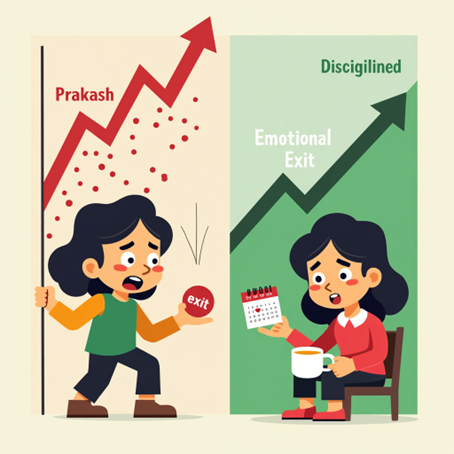There are no items in your cart
Add More
Add More
| Item Details | Price | ||
|---|---|---|---|
Introduction
Imagine losing ₹1,000. Now imagine gaining ₹1,000. Most people feel the pain of the loss much more than the joy of the gain. This is loss aversion — a powerful behavioural bias that causes investors to exit mutual funds prematurely, especially during downturns. In this blog, we explore what loss aversion is, how it leads to bad decisions, and how two investors — Prakash and Neha — handled the same market dip very differently.
11/06/2025

Loss aversion refers to our tendency to avoid losses more strongly than we seek equivalent gains.
In investing, this means we:
Panic when markets fall
Sell too early to “cut losses”
Miss the recovery and long-term compounding
It’s emotional, not logical — and it hurts returns.

Real-Life Example: Prakash vs Neha
| Psychological Bias | Investor Behavior | Impact on Returns |
|---|---|---|
| Loss Aversion | Exiting after small temporary losses | Locks in loss, misses rebound |
| Patience & Discipline | Staying invested through downturns | Enables recovery and growth |
| SIP Continuation | Buying more units at low NAVs | Improves long-term return |
Conclusion
Losses are part of the journey — but exiting early turns temporary dips into permanent losses. Recognizing and managing emotional biases like loss aversion is key to becoming a successful mutual fund investor.
Next time the market dips, pause before acting. Stick to your SIP, consult your advisor, and remember: investing is a long game. Don't let fear steal your future gains.
Summary Table: Loss Aversion Impact
| Investor Type | Avg. Return (10 Yr CAGR) | Avg. Risk (Volatility) | Avg. Investor Behaviour |
|---|---|---|---|
| Exits on loss (like Prakash) | 5% – 6% | Medium-High | Emotion-driven, panic exits |
| Holds SIP (like Neha) | 10% – 12% | High | Rational, continues investments |
| Hybrid investors | 7% – 8.5% | Medium | Moderate reaction, some rebalancing |

Dr. Satish Vadapalli
Research Analyst